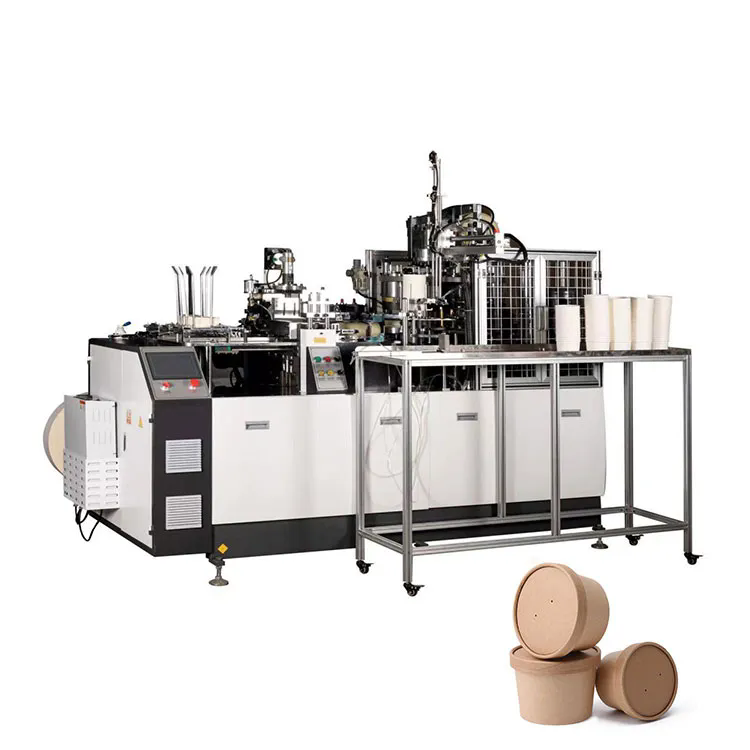The Rise of Paper Soup Bowl Making Machines: Revolutionizing Sustainable Dining Solutions
2024-08-15
In an era where environmental consciousness is increasingly influencing consumer choices, the need for sustainable dining solutions has never been more pressing. Paper soup bowls, a popular alternative to traditional plastic and foam options, are gaining traction due to their eco-friendly attributes. Central to this shift is the paper soup bowl making machine, a vital piece of equipment in the production of these sustainable dining products. Let’s explore how these machines work, their benefits, and why they are becoming an essential component in modern manufacturing.
1. Understanding Paper Soup Bowl Making Machines
Paper soup bowl making machines are specialized equipment designed to produce paper bowls used for serving soups, stews, and other hot or cold foods. These machines are engineered to handle various types of paper and produce bowls with precise dimensions and quality. The process typically involves several stages, including forming, molding, and finishing the bowls.
2. How Paper Soup Bowl Making Machines Work
The production process with a paper soup bowl making machine generally involves the following steps:
- Paper Feeding: The machine starts by feeding rolls of paper or paperboard into the system. This paper is often coated with a layer of polyethylene or other protective materials to make it resistant to moisture and grease.
- Die Cutting: The paper is cut into specific shapes using dies. These shapes are usually circular or oval, depending on the desired bowl size.
- Forming: The cut paper pieces are then shaped into bowls using a series of molds and presses. The forming process involves heating the paper to make it pliable and pressing it into the mold to achieve the desired bowl shape.
- Sealing: In some machines, the bowls are sealed with a layer of coating or adhesive to ensure they are leak-proof and durable. This coating helps protect the paper from absorbing liquids and maintains the bowl’s integrity during use.
- Cooling and Stacking: Once formed, the bowls are cooled and stacked for packaging. Automated systems often handle this process to ensure efficiency and consistency.
3. Benefits of Using Paper Soup Bowl Making Machines
Investing in paper soup bowl making machines offers several advantages for manufacturers and consumers alike:
- Environmental Sustainability: Paper bowls are biodegradable and compostable, making them a more environmentally friendly option compared to plastic or foam bowls. By using these machines, manufacturers contribute to reducing plastic waste and promoting sustainability.
- Cost-Effective Production: Modern paper soup bowl making machines are designed for efficiency and high output. They reduce labor costs and increase production rates, making it economically viable to produce large quantities of bowls.
- Versatility: These machines can produce various sizes and types of bowls, including those with different coatings and finishes. This versatility allows manufacturers to cater to diverse market needs and preferences.
- Improved Quality: Advanced paper bowl making machines ensure consistent quality and durability in the final product. The precision of the forming and sealing processes results in bowls that are sturdy and reliable.
- Enhanced Hygiene: Paper soup bowls are often preferred in food service due to their hygienic nature. The use of these machines helps ensure that the bowls meet food safety standards and are free from contaminants.
4. Applications of Paper Soup Bowl Making Machines
Paper soup bowl making machines are used in various settings, including:
- Food Service Industry: Restaurants, cafes, and food trucks use paper soup bowls for serving soups, stews, and takeout meals. The machines help produce high-quality, eco-friendly bowls for everyday use.
- Catering and Events: Catering services and event organizers use paper soup bowls for large gatherings and events. The convenience and sustainability of paper bowls make them a popular choice for such occasions.
- Retail and Packaging: Manufacturers produce paper soup bowls for retail sale, offering consumers a sustainable alternative to disposable plastic and foam products.
5. Choosing the Right Paper Soup Bowl Making Machine
When selecting a paper soup bowl making machine, consider the following factors:
- Production Capacity: Choose a machine that matches your production needs. Consider the volume of bowls required and select a machine with the appropriate capacity and speed.
- Machine Features: Look for machines with advanced features such as automated feeding, precise molding, and efficient sealing processes. These features contribute to higher quality and more consistent production.
- Material Compatibility: Ensure the machine is compatible with the types of paper and coatings you plan to use. This compatibility is crucial for producing high-quality, durable bowls.
- Maintenance and Support: Opt for a machine from a reputable manufacturer that offers reliable maintenance and technical support. Regular maintenance ensures the machine operates efficiently and extends its lifespan.
6. The Future of Paper Soup Bowl Production
As consumer demand for eco-friendly products continues to rise, the role of paper soup bowl making machines in the manufacturing process will likely become even more significant. Innovations in materials and technology will drive the development of even more sustainable and efficient solutions, further enhancing the appeal of paper bowls.
By investing in paper soup bowl making machines, manufacturers not only contribute to a greener planet but also meet the growing consumer preference for sustainable dining options. The transition to paper bowls represents a step forward in reducing environmental impact while providing practical and attractive solutions for the food service industry.
In conclusion, paper soup bowl making machines are a vital part of the move towards more sustainable packaging solutions. Their ability to produce high-quality, eco-friendly bowls efficiently and economically positions them as an essential tool in modern manufacturing. Embracing this technology is a win-win for both businesses and the environment.



